Kentucky Pest News Newsletter
HIGHLIGHTS IN THIS ISSUE
Number 1023__________June 1, 2004
TOBACCO
CORN
FORAGE
WHEAT
FRUIT
SHADE TREES AND ORNAMENTALS
PESTS OF HUMANS
DIAGNOSTIC LAB HIGHLIGHTS
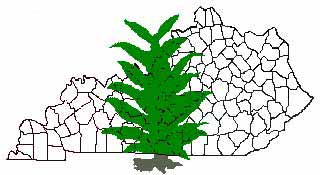
TOBACCO
CURRENT BLUE MOLD STATUS
By William Nesmith
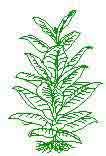 As of press time, noon June 1, no additional counties had
reported blue mold activity. However, some additional
activity was reported during the past week in both Taylor
and Jessamine counties; some connected to out-plantings
from the initial finds but others from unrelated farming
activities.
As of press time, noon June 1, no additional counties had
reported blue mold activity. However, some additional
activity was reported during the past week in both Taylor
and Jessamine counties; some connected to out-plantings
from the initial finds but others from unrelated farming
activities.
Weather conditions during the past week were highly
favorable for blue mold activity to build and spread,
especially in transplants. Although prevailing winds
should have moved inoculum mainly north and east from
sources, the series of strong storm systems experienced
during the past week could have moved inoculum in any
direction.
Laboratory assays conducted with samples collected from
Taylor, Green, and Jessamine counties indicate the current
blue mold strain is resistant (insensitive) to mefenoxam,
with equal sporulation occurring on treated and untreated
leaves. This would support the hypothesis that the
pathogen came from cultivated tobacco rather than the
wild tobacco in Texas.
For the latest blue mold status and other tobacco disease information, check the KY Blue Mold Warning System online.
 http://www.uky.edu/Agriculture/kpn/kyblue/kyblue.htm
http://www.uky.edu/Agriculture/kpn/kyblue/kyblue.htm
Be sure to note the new fungicide options covered in
another article in this issue of Kentucky Pest News.
NEW FUNGICIDE OPTION FOR BLUE MOLD CONTROL REQUIRES TANK MIXING ON THE FARM
By William Nesmith
BASF Corporation representatives informed us last week
that they have stopped manufacturing Acrobat MZ (a
prepackage mixture of dimethomorph and mancozeb).
Regional growers have relied on this fungicide for several
years. BASF's inventory of Acrobat MZ has been depleted.
Some product remains in local stores and on farms, and
these can still be sold and used as the Kentucky 24(c) is
effective through December 31, 2005. However, another
option is available, tank mixing Acrobat 50 WP
(dimethomorph) and Dithane DF Rainshield (mancozeb).
Acrobat 50 WP has a national label for tobacco but because
it contains only dimethomorph, the label prohibits
application except in tank mixtures. Actigard 50 WP (a
plant inducer) is not an appropriate mixing partner,
because the methods of application between the two are
very different. Also, Acrobat 50 WP cannot be tank mixed
with metalaxyl or mefenoxam, even though they are
labeled for blue mold control in the field, because of
differences in application methods and label prohibitions.
In Kentucky, the only current option for tank mixing is
Dithane DF Rainshield, which is labeled under a 24(c)
through December 31, 2004.
Because thorough coverage is critical to control and
resistance management, use is allowed only with tractor-
driven, air-blast, mist blower sprayers, and certain aerial
equipment. Use in hand-pump and other low-pressure sprayers
is prohibited due to poor coverage. Use of Acrobat 50 WP alone
is prohibited. Use in all transplant production systems and the
transplant water are also prohibited.
The rate of Acrobat 50 WP is 7 oz/100 gallons of water,
using 20 gallons of this solution when the plants are small
increasing the volume as the plants grow (see label). The
label has good directions for the mixing rates at various
stages of growth, but one will need to consult the label of
the mixing partner to determine the actual amount of
fungicides to have in the spray tank. For aerial
applications, use 8 oz of product per acre, in at least 15
gallons of water per acre, regardless of the stage of the
crop. Do not exceed 32 oz/acre total for the season.
The following able is provided as an aid to growers in
making calculations for tank mixing Acrobat 50 WP and
Dithane DF Rainshield.
Supplemental Table (for Field Use Only)
Tank Mix Rates for Acrobat 50WP + Dithane DF Rainshield
Application Timing, Rates and Spray Volumes To Control Blue Mold |
|
|
| Weeks of GrowthAfter Transplant |
Tank Mix Rate(Ounces of Product) |
Spray VolumeFor Tractor-Driven Sprayer(Gallons/Acre) |
Spray Volume forBackpack Mist Blowers(Gallons/Acre) |
| Acrobat 50WP |
Dithane DF* |
Recently transplanted to 3 weeks after transplanting |
2 |
6 |
20 |
10 |
3-4 Weeks after transplanting(Knee High) |
3 |
12 |
40 |
20 |
4-5 Weeks after transplanting(Waist High) |
4 |
18 |
60 |
30 |
6-7 Weeks after transplanting(Chest High) |
6 |
24 |
80 |
40 |
7 Weeks after transplanting and beyond(Shoulder Height Up to Topping) |
7 |
30 |
100 |
50 |
*Dithane DF Rainshield
Read and follow labels for both products carefully. Note, with tank
mixtures the PHI and REI fall to the product with the most restrictions,
in this case the Dithane. So, Post Harvest Interval is 30 days and
Rentry Interval is 24 hours.
Website with labels:
Acrobat 50 WP, select tobacco label at:
http://www.cdms.net/manuf/1prod.asp?pd=4817&lc=1
Dithane DF Rainshield, select Ky 24c at:
http://www.cdms.net/manuf/1prod.asp?pd=4800&lc=1

For more information about tobacco pests, visit
"Insect Management Recommendations".
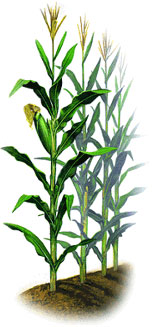
CORN
SOUTHWESTERN CORN BORER ACTIVE
By Ric Bessin
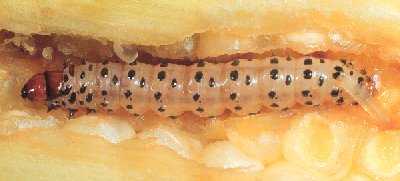 Southwestern corn borer larvae are active in some fields,
particularly in early-planted corn. While any European
corn borer larvae have passed the 'treatable' stage,
Southwestern corn borer lags several weeks behind in
development and the young larvae are beginning to attack
corn. Unfortunately, this means that at the time we can
stop monitoring for ECB, we need to begin monitoring for
SWCB. As the summer progresses, when we stop
monitoring for first generation SWCB, we will need to
begin monitoring for second-generation ECB.
The early-planted corn is more attractive to the first
generation of SWCB. With second and third generation
ECB and SWCB, it will be the later plantings which are
more attractive. Growers should monitor their field for
SWCB and use a threshold of 35% infested plants with live
larvae in the whorl as the threshold for treatment.
Southwestern corn borer larvae are active in some fields,
particularly in early-planted corn. While any European
corn borer larvae have passed the 'treatable' stage,
Southwestern corn borer lags several weeks behind in
development and the young larvae are beginning to attack
corn. Unfortunately, this means that at the time we can
stop monitoring for ECB, we need to begin monitoring for
SWCB. As the summer progresses, when we stop
monitoring for first generation SWCB, we will need to
begin monitoring for second-generation ECB.
The early-planted corn is more attractive to the first
generation of SWCB. With second and third generation
ECB and SWCB, it will be the later plantings which are
more attractive. Growers should monitor their field for
SWCB and use a threshold of 35% infested plants with live
larvae in the whorl as the threshold for treatment.
For information about corn pests, visit
"Insect Management Recommendations".


FORAGE
ERGOT RISK IN TALL FESCUE
By Paul Vincelli
Recent humid, rainy weather with moderate temperatures
during the period of flowering of tall fescue may have
been favorable for infection of the flowers by the ergot
fungus Claviceps purpurea. C. purpurea is related to the
fungal endophyte of tall fescue, and both are capable of
producing potent toxic alkaloids that affect animal health
(and human health, if eaten). This is not a trivial issue; I
once was subpoenaed to give a deposition in a case in
Kentucky with economic losses of over $2 million, in
which ergot was implicated as the cause.
The ergot fungus infects only the flower parts of certain
grasses, and replaces the seed with "ergots". Ergots are
survival bodies of the fungus that are easily recognized
with the naked eye. They look like dark brown to black,
curved cigars measuring 1/8 inch to 3/8 inch. They are
longer than grass seed, so they stick out beyond the
glumes. If you cut them open, you'll see that they have a
gray to whitish interior. These ergots will be evident as
the seedheads approach maturity.
Management
Preventing livestock from consuming a significant dose of
ergot sclerotia is the only reasonable course of action.
- Pasture
If seedheads form, inspect them for ergots. If they are
found, mow before turning livestock out into the pasture.
Mow the seedheads along the fencerow, as well.
- Hay
If the seedheads are dry before harvesting, the ergot
sclerotia will often fall to the ground during
cutting/tedding/baling. However, if the seedheads were
still somewhat green when cut, the sclerotia can remain
attached to the seedhead, and will end up in the bale. In
harvested hay, ergot sclerotia constitute a very small
fraction of the total forage in the bale. Because of this, the
risk from feeding these bales is low. However, repeated
feeding of infested hay into a feedbunk can lead to
accumulation of the ergot sclerotia at the bottom of the
bunk. Livestock may then consume a high dose of
sclerotia when they feed on this residue.
- Seed Production
Where tall fescue is being grown for seed, avoid feeding
screenings that may be contaminated with ergot sclerotia.
Seed-cleaning operations concentrate the sclerotia and can
pose a great hazard if fed to livestock.

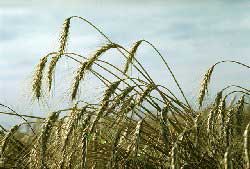
WHEAT
FUSARIUM HEAD BLIGHT UPDATE
By Don Hershman

It is not clear at this time how extensive FHB is in
Kentucky. However, initial reports suggest that serious
disease conditions exist in many fields throughout the
state. What I have heard from others, and my personal
observation, is that 40-70% FHB incidence is common. A
relatively small percentage of fields I have seen have low
double digit or single digit incidences. On the other end of
the spectrum, fields with 80%+ incidence are all too
common. Not all areas of the state are equally impacted.
The greatest damage due to FHB appears to exist in the
southern Purchase Area, portions of the Green River and
Pennyrile Areas, most of the Mammoth Cave Area, and
the area extending east of Elizabethtown to Lexington.
We will not know full yield and quality impact of FHB
until harvest. My impression at this time is that the overall
impact will exceed that of last year, but will not be as
serious as 1991. Prior to FHB developing, the state wheat
yield potential was very high, which may help reduce
some of the yield impact.
It appears that Folicur was not extensively used, or it was
applied too late to be of value. In the southern counties,
the lack of use appears to be related to the late date (April
15) when the section 18 was officially approved by EPA.
By the time product was available and growers were made
aware of the emergency label, many fields were already in
bloom. This situation was made more acute by the
accelerated rate of crop development this spring. Rain and
other logistical considerations also resulted in fields not
getting sprayed or being sprayed too late to be effective.
It will be some time before we have a complete picture of
how Folicur performed where it was sprayed in a timely
fashion. In the meantime, I have summarized, but not
statistically analyzed, data from a study I conducted at the
UKREC in Princeton this year. Normally I would not
report data which has not been statistically analyzed, but
the results seem to reflect how Folicur has been
performing in grower fields and in other field studies. So, I
thought I would go out on a limb and report preliminary
findings at this time.
The following are treatment means for six replications for
the variety "Sisson" treated (backpack CO2 sprayer) with
various labeled fungicides at early bloom on 3 May, 2004.
| Fusarium Head Blight** |
|
| Fungicide* |
Rate/A |
% Incidence |
% Severity |
% Index |
% Control (index) |
| Non-treated |
-- |
76.4 |
22.7 |
17.4 |
-- |
| Headline |
6 fl oz |
77.2 |
21.8 |
16.8 |
3.4 |
| Quilt |
14 fl oz |
69.9 |
18.7 |
13.1 |
24.7 |
| Tilt |
4 fl oz |
67.9 |
16.9 |
11.8 |
32.2 |
| Folicur |
4 fl oz |
60.4 |
17.7 |
10.8 |
37.9 |
* all treatments included 0.125% v/v induce.
**Fusarium Head Blight (FHB) ratings terms are defined as: %
Incidence = proportion of heads with symptoms; % Severity = surface
area diseased for heads showing symptoms; index is incidence x
severity/100; index is a rough estimate of the upper end of yield loss
that might occur based on FHB incidence and severity; and, %
control (index) is the % change in disease control due to treatment as
measured against the control (control index value - treatment index
value)/control index value.
The above data reasonably reflect the FHB results using
Folicur in numerous winter wheat trials conducted since
1998. As expected, Folicur impacted FHB incidence or
more than severity . Thus, if visual differences are
apparent where Folicur has been applied compared with
non-treated wheat, this difference is probably due to your
eye picking up fewer heads with symptoms. Unless you
actually make individual head ratings, it is very hard to
tell which aspect of FHB symptom expression is being
affected most - incidence or severity.
Most fields in the state are past the point where FHB
symptoms can be easily seen. If you have not checked for
symptoms before now, you can still get some idea of the
extent of FHB by arbitrarily checking heads for the extent
of shriveled grain and pinkish discoloration. If you find
that shriveled grain is common, you may wish to adjust
your combine so that most of the light weight grain blows
out the back of the unit during harvest.
See "Insect Management Recommendations" for more wheat pest information.

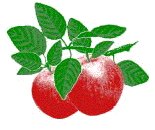
FRUIT
APPLE FOLIAR DISEASES ARE PREVALENT
By John Hartman
 With rainy periods fairly common in many parts of
Kentucky these past two months, conditions were
conducive for development of several foliar diseases of
commercial and backyard apple trees this spring. Growers
who were able to apply fungicides in a timely way are
having good success in disease management, but
unsprayed trees or those which failed to receive critical
sprays are showing numerous symptoms now.
With rainy periods fairly common in many parts of
Kentucky these past two months, conditions were
conducive for development of several foliar diseases of
commercial and backyard apple trees this spring. Growers
who were able to apply fungicides in a timely way are
having good success in disease management, but
unsprayed trees or those which failed to receive critical
sprays are showing numerous symptoms now.
Apple scab.
Ascospores of the fungus Venturia inaequalis
initiate primary apple scab infections when the leaves are
wet for a sufficient length of time. Symptoms consisting of
olive-green velvety fungal growth appear on the leaves a
week or so after infection. These symptoms being seen
now are the fungal thallus and conidia responsible for
continued cycles of secondary infection whenever it is wet
throughout the season.. The parts of the leaf associated
with the fungus develop into dark brown necrotic lesions.
Eventually infected leaves turn yellow and drop from the
tree, leaving the tree prematurely defoliated.
Weather data were collected and apple scab disease
forecasting programs were run at the U.K. West Kentucky
Research and Education Center in Princeton, and in
Lexington at the U.K. Horticultural Research Farm this
spring. Based on these data, severe apple scab infections
likely occurred in most Kentucky orchards on unprotected
susceptible trees during the periods of March 29 - April 1;
April 12-14 and 21-25; April 29 - May 3; May 10-11, 12-17,
17-20 and the week of May 26-30. Three of these 8 or more
infection periods lasted 85 or more intermittent hours at
temperatures where 15 or 20 hours would have sufficed to
favor severe infections.
Cedar-apple rust.
Small orange spots have been appearing
for the past two weeks on apple leaves infected with
cedar-apple rust disease caused by the fungus
Gymnosporangium juniperi-virginianae. There is no
secondary cycle of infection from these spots, but the spots
will develop and enlarge until they produce spores that
will cycle back to infect nearby cedar trees this summer.
Cedar-apple rust needs leaf wetness for infection, but for a
much shorter time than that needed for scab. Thus, it
appears that there were dozens of periods for infection this
spring.
Frogeye leaf spot.
Symptoms of frogeye leaf spot are
plainly evident on apple leaves throughout Kentucky now.
In many plantings in eastern Kentucky, frogeye leaf spot
will be more prevalent than other diseases such as scab or
rust which are also visible now. The symptoms appearing
now on leaves are small (1/8 - 1/4 inch) distinct circular,
brown spots. The center portion of the spot may become
tan colored, while the outer edge remains dark brown,
giving it a frogeye appearance. Signs of disease in the
form of tiny black pycnidia (fungal fruiting bodies) of the
causal fungus may develop in the center of the spot.
Pycnidia can be examined with the aid of a hand lens and
will appear as tiny black "pimples" when viewed through
the magnifier. These pycnidia contain thousands of spores
that are the source of continued infections. As leaf spots
become more numerous and coalesce, leaves yellow and
fall. Frogeye leaf spot is caused by the fungus
Botryosphaeria obtusa, a fungus which also causes black rot
of apple fruits and a canker of the twigs and branches.
Often a cone-shaped area of affected leaves will appear
just beneath such a canker. Frogeye leaf spot infections are
also favored by wet weather.
Powdery mildew.
Powdery mildew, caused by the fungus
Podosphaera leucotricha, is being observed frequently in
apples this season. This disease can seriously reduce the
vigor and productivity of apple trees. The mildew fungus
may deform, stunt, or kill twigs, leaves, blossoms and
fruit. Infected fruits may become severely russeted. Gray
to white felt-like patches occur on the leaves and on new
twigs. Leaves are narrow, crinkled, and folded
lengthwise, and they become thickened. Disease pressure
from powdery mildew is usually greater in growing
seasons following relatively mild winters which we have
been experiencing for the past several years.
Fire blight.
Fire blight disease is being observed
sporadically this spring. This bacterial disease, caused by
Erwinia amylovora, has the potential to be very destructive.
During apple bloom, when primary infections occur,
weather was generally not favorable for infection. Our
weather instruments and disease predictive programs at
the U.K. research farms indicated that one or possibly only
two times during bloom were favorable for infections this
year. However, more recent severe weather events such as
high winds or hail could have provided the entry the
bacteria needed to infect the still-succulent shoots.
Since weather conditions statewide have varied a great
deal from one location to the other, growers may have
faced more or less disease pressure than we monitored at
the U.K. research farms. Thus, growers will need to
manage apple diseases based on what is occurring in their
orchard. Guidelines on apple disease management can be
found in the U.K. Cooperative Extension publication 2004
Commercial Tree Fruit Spray Guide (ID-92) and in the
Midwest Tree Fruit Handbook, available at county extension
offices statewide.
SAN JOSE SCALE CRAWLERS ACTIVE
By Ric Bessin
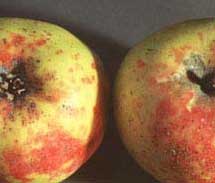 San Jose scale crawlers are now active on apples, pears,
and peaches. The crawler stage is when the scale is most
vulnerable to sprays and can be controlled relatively
easily. San Jose scale is one of the key pests of these
orchard crops.
San Jose scale crawlers are now active on apples, pears,
and peaches. The crawler stage is when the scale is most
vulnerable to sprays and can be controlled relatively
easily. San Jose scale is one of the key pests of these
orchard crops.
San Jose scale is one of the few insects that can reduce the
health of the orchard. While feeding the scale injects
enzymes into the tree that are toxic. The wood beneath the
bark near the feeding sites turns a scarlet color due to these
toxins. Large numbers of scales can encrust limbs causing
limb dieback and eventual death of the tree. Peach trees
are particularly susceptible to scale injury.
The primary insecticide for control of scale is an insect
growth regulator that is applied at the pre-bloom stage or
during the crawler period, which is occurring now. During
the next few days, the scale crawlers will settle on leaves,
fruit, and bark to begin feeding. Once settled, that will not
move again. They begin to produce a tough, protective cap
which protects them from predators and insecticides. This
is why timing is critical to achieve good control.

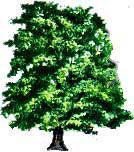
SHADE TREES AND ORNAMENTALS
GALLS SHOWING UP ON LEAVES NOW
By Lee Townsend
Galls are irregular plant growths that are stimulated by the
reaction between plant hormones and powerful growth
regulating chemicals that can be produced by some insects
or mites. Galls may occur on leaves, bark, flowers, buds,
acorns, or roots. Leaf and twig galls are most noticeable.
The inhabitant gains its nutrients from the inner gall
tissue. Galls also provide some protection from natural
enemies and insecticide sprays. Important details of the
life cycles of many gall-makers are not known so specific
recommendations to time control measures most
effectively are not available. Gall makers must attack at a
particular time in the year to be successful. Otherwise,
they may not be able to stimulate the plant to produce the
tissue that forms the gall.
Generally, initiation of leaf galls occurs around "bud
break" or as new leaves begin to unfold in the spring. Oaks
are susceptible to many gall makers. The woolly fold gall,
caused by a small fly, is a striking example. A fuzzy white
pubescence appears on the leaf and is associated with a
pouch that contains the maggots larval stage of the fly.
Galled leaves are deformed but overall tree health is not
affected adversely. Information on several common shade
tree galls is available in Entfacts 403, 404, and 408.

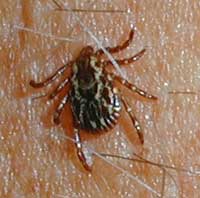
PESTS OF HUMANS
RAINS FORM POOLS FOR COMMON FLOODWATER MOSQUITOES
By Lee Townsend
 Floodwater mosquitoes develop in pools that form in low
areas following rains. Parades of thunderstorms across the
Commonwealth have left thousands of temporary pools in
ditch banks, wheel ruts, and other low spots. This water
will stimulate mosquito eggs previously laid on vegetation
in areas that are prone to seasonal flooding to hatch. The
mosquito then will quickly move through their life cycle.
Several of our important nuisance and vector mosquitoes
breed in these situations and are likely to increase in
numbers dramatically in the next few weeks. Some
mosquito species can move several miles, causing
problems far from their breeding site. Here are a few short
profiles-
Floodwater mosquitoes develop in pools that form in low
areas following rains. Parades of thunderstorms across the
Commonwealth have left thousands of temporary pools in
ditch banks, wheel ruts, and other low spots. This water
will stimulate mosquito eggs previously laid on vegetation
in areas that are prone to seasonal flooding to hatch. The
mosquito then will quickly move through their life cycle.
Several of our important nuisance and vector mosquitoes
breed in these situations and are likely to increase in
numbers dramatically in the next few weeks. Some
mosquito species can move several miles, causing
problems far from their breeding site. Here are a few short
profiles-
Black salt marsh mosquito Orchlerotatus taeniorhynchus,
a dark mosquito with a painful bite attacks birds,
mammals, and humans. Eggs are laid on the ground in
low areas that flood seasonally. The larvae can be found in
salt marsh or brackish waters. Females generally feed in
the evening but not after dark. They generally remain
within 2 to 5 miles of their breeding site but winds may
move them 30 miles or more.
Flood water mosquito Orchlerotatus trivittatus is a
persistent, aggressive mosquito that gives a very painful
and irritating bite. The larvae can be found in most any
collection of freshwater from open pools to temporary rain
pools. They appear first in late spring and continue to
breed during the summer. When temperatures are in the
80's to 90's with warm nights, development from egg to
adult can take as little as 5 days. Adults bite mainly in
evening, resting in shaded grasses and other vegetation
during the day. They are not considered to be important
disease vectors.
Inland floodwater mosquito Aedes vexans is one of the
most widespread pest mosquitoes in the world. It can
breed in most any ground pool following flooding of the
eggs. It is a significant and chronic pest in western
Kentucky. There are several generations each year. Adults
rest on vegetation and shaded grass during the day and
become vicious biters at dusk and after dark. They can live
for several weeks and may migrate10 miles or more during
that time. The vexans mosquito is a potential vector of St
Louis encephalitis. It is a vector of dog heartworm in some
areas of the US and has tested positive for West Nile virus
in the field.
Dark ricefield mosquito Psorophora columbiae, a large
dark mosquito with white or yellow markings, is a serious
nuisance to humans and livestock. The eggs are laid on
moist soil and the larvae develop rapidly in temporary
freshwater pools such as grassy roadside ditches.
Draining temporary pools and clearing drainage channels
are means of eliminating breeding areas. Pools with active
wrigglers can be treated with products containing Bacillus
thuringiensis israelensis, a strain of Bt that controls
mosquito larvae,

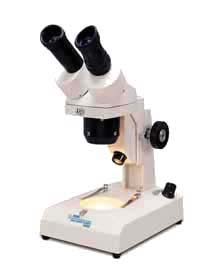
DIAGNOSTIC LAB HIGHLIGHTS
DIAGNOSTIC LAB - HIGHLIGHTS
By Julie Beale and Paul Bachi
Diagnostic samples during the past week included zinc
deficiency and stinkbug injury on corn; Lepto leaf spot on
alfalfa; black shank, blue mold, target spot, frogeye leaf
spot, anthracnose, angular leaf spot, blackleg, Pythium
root rot, potash deficiency and fertilizer burn on tobacco.
On fruit and vegetable samples, we saw black rot on
grape; tobacco ringspot virus on blackberry;
Mycosphaerella leaf spot, red stele (Phytophthora),
anthracnose crown rot and Pythium root rot on
strawberry; leaf curl and scab on peach; cedar-apple rust,
fireblight, and frogeye leaf spot on apple; white rot
(Sclerotium) on garlic; Pythium root rot on pepper; and
bacterial canker, early blight, Septoria leaf spot, and
growth regulator injury on tomato.
On ornamentals and turf, we saw leaf streak on daylily;
Botrytis blight on rose; witch hazel aphid on birch; crown
rust on buckthorn; anthracnose and Phyllosticta leaf spot
on maple; fireblight on serviceberry; Rhizosphaera
needlecast on spruce; and Phyllosticta leaf blight on witch
hazel.

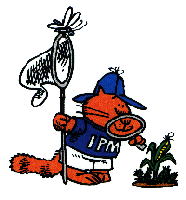
IPM TRAP COUNTS:
By Patty Lucas, University of Kentucky Research Center
UKREC-Princeton, KY, May 21-28 , 2004
| Southwestern Corn Borer
| 23
|
| True Armyworm
| 2
|
| Corn Earworm
| 33
|
| European Corn Borer
| 0
|
|
Cam Kenimer reports the following trap counts for Fulton County May 19 - 26
| True Armyworm
| 23
|
| European Corn Borer
| 2
|
| Southwestern Corn Borer
| 64
|
|
To view previous trap counts for Fulton County, Kentucky
go to - http://ces.ca.uky.edu/fulton/anr/
and click on "Insect Trap Counts".
For information on trap counts in southern Illinois visit the
Hines Report at -
http://www.ipm.uiuc.edu/pubs/hines_report/index.html.
The Hines Report is posted weekly by Ron Hines, Senior
Research Specialist, at the University of Illinois Dixon
Springs Agricultural Center
Category
Article title
By xxxxx x xxxxxx

MISCELLANEOUS
XXXXXXXXXXXXXXX
By xxxxxxxxxx

NOTE: Trade names are used to simplify the information presented in
this newsletter. No endorsement by the Cooperative Extension Service
is intended, nor is criticism implied of similar products that are not
named.
Lee Townsend
Extension Entomologist
BACK
TO KY PEST NEWS HOME
 As of press time, noon June 1, no additional counties had
reported blue mold activity. However, some additional
activity was reported during the past week in both Taylor
and Jessamine counties; some connected to out-plantings
from the initial finds but others from unrelated farming
activities.
As of press time, noon June 1, no additional counties had
reported blue mold activity. However, some additional
activity was reported during the past week in both Taylor
and Jessamine counties; some connected to out-plantings
from the initial finds but others from unrelated farming
activities.



 Southwestern corn borer larvae are active in some fields,
particularly in early-planted corn. While any European
corn borer larvae have passed the 'treatable' stage,
Southwestern corn borer lags several weeks behind in
development and the young larvae are beginning to attack
corn. Unfortunately, this means that at the time we can
stop monitoring for ECB, we need to begin monitoring for
SWCB. As the summer progresses, when we stop
monitoring for first generation SWCB, we will need to
begin monitoring for second-generation ECB.
The early-planted corn is more attractive to the first
generation of SWCB. With second and third generation
ECB and SWCB, it will be the later plantings which are
more attractive. Growers should monitor their field for
SWCB and use a threshold of 35% infested plants with live
larvae in the whorl as the threshold for treatment.
Southwestern corn borer larvae are active in some fields,
particularly in early-planted corn. While any European
corn borer larvae have passed the 'treatable' stage,
Southwestern corn borer lags several weeks behind in
development and the young larvae are beginning to attack
corn. Unfortunately, this means that at the time we can
stop monitoring for ECB, we need to begin monitoring for
SWCB. As the summer progresses, when we stop
monitoring for first generation SWCB, we will need to
begin monitoring for second-generation ECB.
The early-planted corn is more attractive to the first
generation of SWCB. With second and third generation
ECB and SWCB, it will be the later plantings which are
more attractive. Growers should monitor their field for
SWCB and use a threshold of 35% infested plants with live
larvae in the whorl as the threshold for treatment.




 With rainy periods fairly common in many parts of
Kentucky these past two months, conditions were
conducive for development of several foliar diseases of
commercial and backyard apple trees this spring. Growers
who were able to apply fungicides in a timely way are
having good success in disease management, but
unsprayed trees or those which failed to receive critical
sprays are showing numerous symptoms now.
With rainy periods fairly common in many parts of
Kentucky these past two months, conditions were
conducive for development of several foliar diseases of
commercial and backyard apple trees this spring. Growers
who were able to apply fungicides in a timely way are
having good success in disease management, but
unsprayed trees or those which failed to receive critical
sprays are showing numerous symptoms now.
 San Jose scale crawlers are now active on apples, pears,
and peaches. The crawler stage is when the scale is most
vulnerable to sprays and can be controlled relatively
easily. San Jose scale is one of the key pests of these
orchard crops.
San Jose scale crawlers are now active on apples, pears,
and peaches. The crawler stage is when the scale is most
vulnerable to sprays and can be controlled relatively
easily. San Jose scale is one of the key pests of these
orchard crops.


 Floodwater mosquitoes develop in pools that form in low
areas following rains. Parades of thunderstorms across the
Commonwealth have left thousands of temporary pools in
ditch banks, wheel ruts, and other low spots. This water
will stimulate mosquito eggs previously laid on vegetation
in areas that are prone to seasonal flooding to hatch. The
mosquito then will quickly move through their life cycle.
Several of our important nuisance and vector mosquitoes
breed in these situations and are likely to increase in
numbers dramatically in the next few weeks. Some
mosquito species can move several miles, causing
problems far from their breeding site. Here are a few short
profiles-
Floodwater mosquitoes develop in pools that form in low
areas following rains. Parades of thunderstorms across the
Commonwealth have left thousands of temporary pools in
ditch banks, wheel ruts, and other low spots. This water
will stimulate mosquito eggs previously laid on vegetation
in areas that are prone to seasonal flooding to hatch. The
mosquito then will quickly move through their life cycle.
Several of our important nuisance and vector mosquitoes
breed in these situations and are likely to increase in
numbers dramatically in the next few weeks. Some
mosquito species can move several miles, causing
problems far from their breeding site. Here are a few short
profiles-

